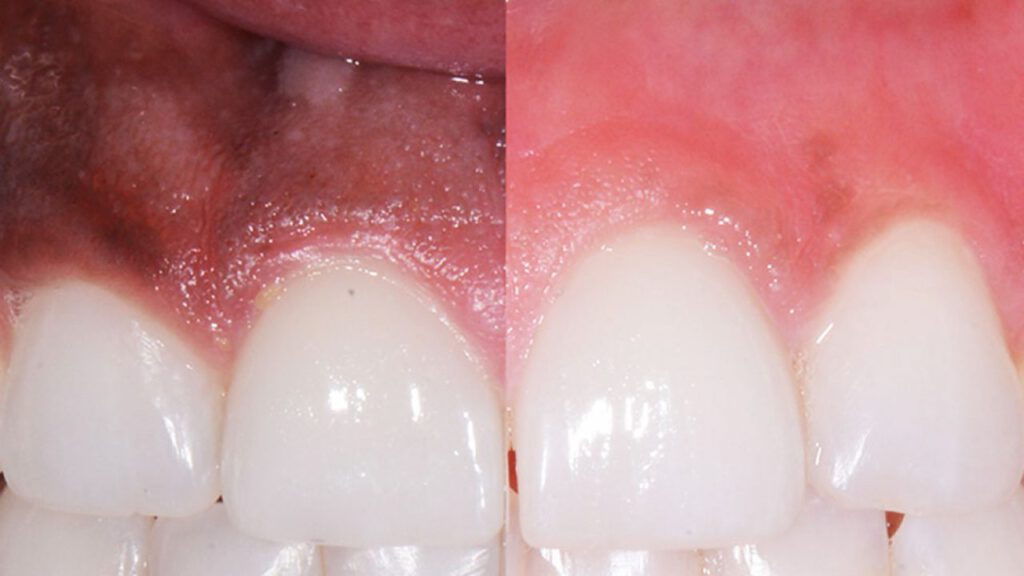
Gums Depigmented
Gums Depigmented is a cosmetic dental procedure used to lighten or remove the dark or discolored areas of the gums. This condition, known as gingival hyperpigmentation, can be caused by a variety of factors, including genetics, medications, and certain medical conditions.
What Are Gums Depigmented:
Gums Depigmented The most common cause of gingival hyperpigmentation is a buildup of melanin, a pigment that gives color to the skin, hair, and eyes. Melanin is produced by cells called melanocytes, which are found in the gums. In some individuals, these cells may produce too much melanin, resulting in dark or discolored gums.
Other factors that can contribute to gingival hyperpigmentation include certain medications, such as tetracycline antibiotics and antipsychotic drugs, as well as certain medical conditions, such as Addison’s disease and Peutz-Jeghers syndrome.
Gums depigmentation can be performed using a variety of techniques, including laser therapy, chemical peels, and surgical excision. The most commonly used method is laser therapy, which uses a high-energy beam of light to remove the dark or discolored areas of the gums.
What We Should Know About The Gums Depigmented:
Laser therapy for gums depigmentation is a relatively simple and safe procedure. During the procedure, the laser is directed at the dark or discolored areas of the gums, breaking down the melanin and removing the discoloration. The procedure typically takes between 30 minutes and one hour, and patients may experience some mild discomfort or sensitivity during the procedure.
Chemical peels, another method used to treat gingival hyperpigmentation, involve the application of a chemical solution to the gums. The solution causes the top layer of the gums to peel away, revealing the lighter, underlying tissue. This method can be more invasive than laser therapy and may require a longer recovery time.
Surgical excision, the third method, involves surgically removing the dark or discolored areas of the gums. This method is more invasive than laser therapy and chemical peels, and may require a longer recovery time.
After the procedure, patients may experience some mild swelling, redness, or tenderness in the treated area. These symptoms typically subside within a few days, and patients can return to their normal activities soon after.
Gums Depigmented:
It’s important to note that the results of gums depigmentation may vary depending on the cause of the gingival hyperpigmentation. In some cases, the discoloration may return after the procedure, and repeat treatments may be necessary.
It’s also important to maintain good oral hygiene following the procedure, as poor oral hygiene can lead to the re-occurrence of gingival hyperpigmentation. This includes regular brushing and flossing, as well as regular dental check-ups.
In conclusion, gums depigmentation is a cosmetic dental procedure used to lighten or remove the dark or discolored areas of the gums caused by gingival hyperpigmentation. This condition can be caused by a variety of factors, including genetics, medications, and certain medical conditions. The procedure can be performed using laser therapy, chemical peels or surgical excision, and it’s important to maintain good oral hygiene following the procedure to prevent the re-occurrence of gingival hyperpigmentation.
Gums Depigmented How To Treat Them?
Gums Depigmented How To get It?
There are a few ways to depigment gums, including using topical creams or gels that contain ingredients like hydroquinone or kojic acid, undergoing laser treatment, or undergoing a surgical procedure called gum depigmentation. It is important to consult with a dentist or dermatologist to determine the best treatment option for your individual case. They will also recommend you best ways to prevent further pigmentation.
Gums Depigmented How Its Work?
Gum depigmentation is a procedure that involves removing the pigmented areas of the gums to create a more uniform appearance. The process can be done surgically or with the use of a laser.
Surgical depigmentation involves removing the pigmented tissue with a scalpel or a laser. This procedure is typically done under local anesthesia and may require several visits to the dentist.
Laser depigmentation is less invasive and can be done in one visit. The laser is used to remove the pigmented tissue and cauterize the blood vessels to stop bleeding. This results in minimal bleeding, less pain and faster healing.
Both methods can be successful in removing pigmentation, but the best method will depend on the individual case and the severity of the pigmentation. A dentist or periodontist will be able to advise you on the most appropriate method for your case.

If you want to get amazing benefits by using this link
Gums Depigmented Conclusion:
In conclusion, depigmentation of the gums is a treatment option for individuals with pigmented gums that are looking to create a more uniform appearance. The procedure can be done surgically or with a laser, and the best method will depend on the individual case and the severity of the pigmentation. It is important to consult with a dentist or periodontist to determine the best treatment option and to discuss any potential risks and benefits. If you have any concerns about your gums, it’s always best to talk to your dentist or periodontist.

